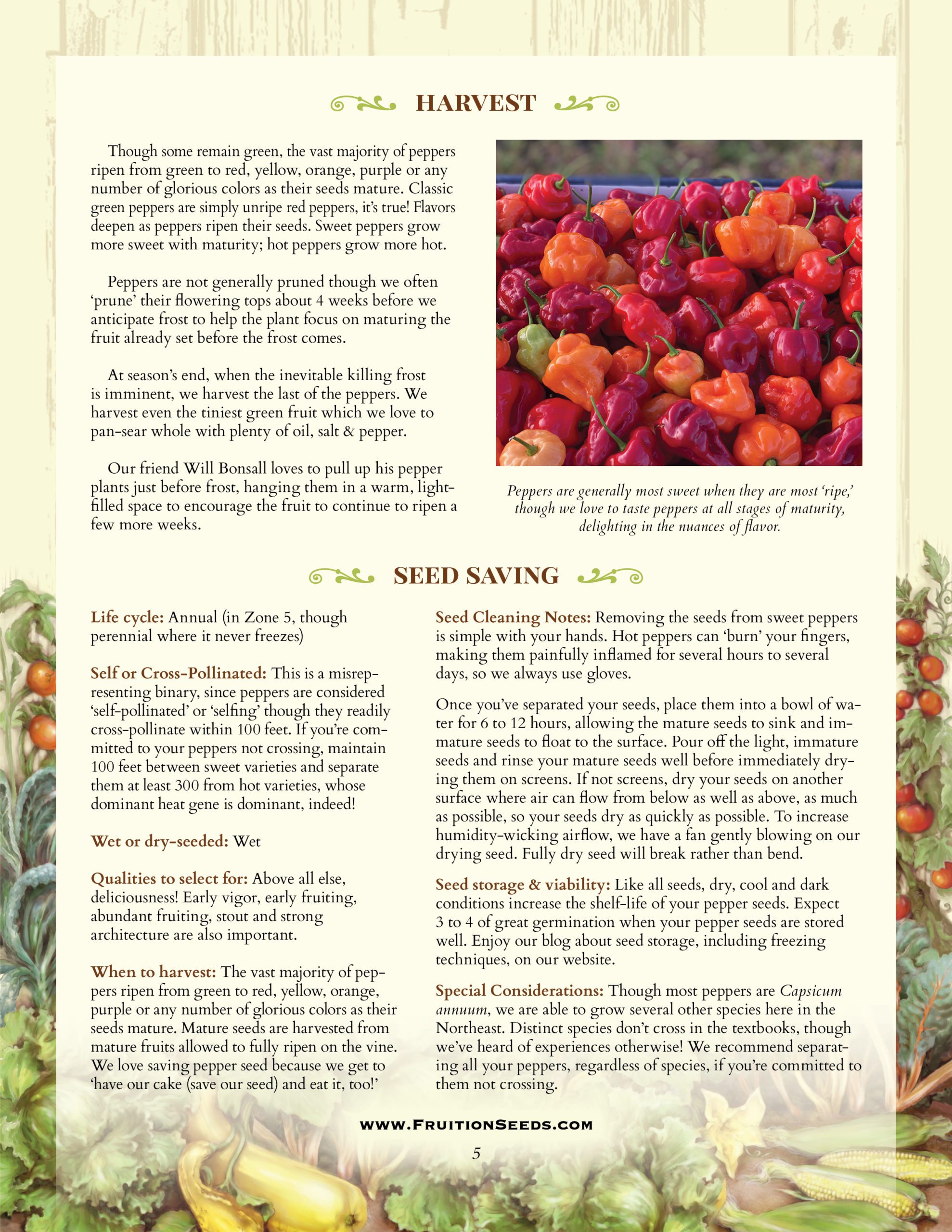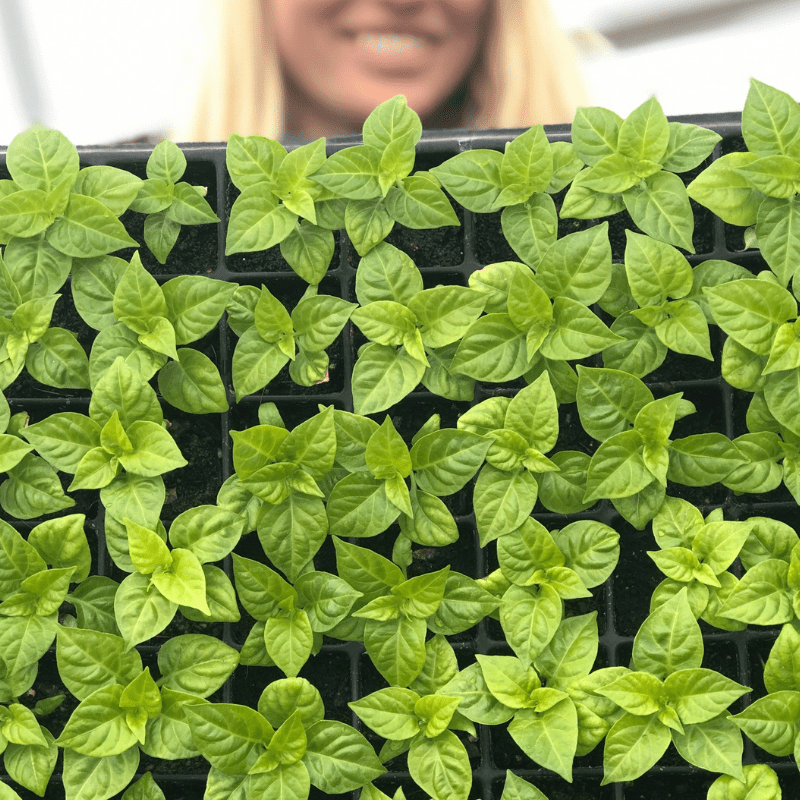Friends, rather than selling and shipping seeds, we now share seeds as an embodied gift practice. Learn how to receive seeds from us & here are our FAQs.
Habanada Sweet Snacking Pepper
Habanada is our favorite pepper, without question. We’ve tasted nothing else like their luscious, tropical divinity.
My first bite I’ll never forget: I couldn’t help but bite gingerly, expecting the fire of Habanero. But then the revelation of impossibly floral, tropical sweetness, without even a hint of heat: Heaven. Michael Mazourek, who’d been selecting this variety for over a decade, laughed and encouraged us to eat the whole thing, seeds and all. Indeed, that is the way. Savoring that first Habanada Sweet Snacking Pepper was one of my favorite experiences of exploding expectation and imagination, especially in food.
An open-pollinated variety from Cornell, we’re confident organic Habanada sweet pepper will be beloved for many generations to come. This is how ‘heirlooms’ are born, Friends! We’re grateful for the countless generations of indigenous seedkeepers who have saved pepper seed for millennia and we are thrilled to share this fresh selection of a heatless habanero, both delicious and abundant, with you ~
Organic Habanda Sweet Snacking Pepper
Planting Method: Transplant Only
When to sow: 8-10 weeks before last frost
Seed Depth: 1/4 inch Days to Germination: 7-10 at 85°F
Sowing and seedling care: Sow indoors 2 seeds per soil block & thin to strongest 1. 80F heat mats will germinate seeds best; after germ, set to 70F days & 60F nights. Habanada is difficult to germinate, preferring your heat mat nice and toasty, ideally 85 F. (But don’t be daunted. Their unmistakable, unforgettable flavor is so extraordinarily worth it.) Good light is essential: Younger, less stressed seedlings are healthier and more abundant than older, more stressed seedlings.
Move to 3-4” pots with first true leaves. Harden off (reduce water & temp 3-7 days) & transplant when night temps are above 50F. Pluck off any flowers at planting. Habanadas will benefit from restricted root growth, no additional nitrogen or compost, good drainage, and additional heat such as row cover or in a green house/hoop-house(especially in the Northeast).
If you are going to fertilize, do so minimally as it will encourage foliage growth rather than fruit development. The do well in a 2-3 gallon pot where you can extend the harvest by bringing them inside or into a greenhouse as the fall temperatures drop.
When to transplant: After last frost
Transplant Spacing: 12-18 inches Sun Needs: Full
Days to Harvest: 80 days to green, 100 days to orange fruit
Fruition’s Growing Guide
















Videos










Natasha (verified owner) –
I 100% will grow these again! I’m in zone 5, IL, USA. Every seed I sowed germinated and grew to a healthy seedling so I ended up giving away a few. It’s now August and the plants are still loaded and at varying stages of ripeness. If I could post a picture of the four beauties I harvested today I would. The flavor is outstanding and everyone I’ve had try them loves them.
Heather (verified owner) –
I am SO happy to hear that you have had an abundant season Natasha! Being able to post photos is such a wonderful thought, may it be so in the very near future 🙂 Habanada’s are magic for certain, thanks for sharing them with people you love <3 Have a wonderful rest of your season and don't be shy! -Heather & The Fruition Team
John Davies –
This is my first year for habanadas and they are amazing. Like habaneros they are slow to ripen but prolific once they start. They have the delicious fruity flavor of habaneros with none of the heat.
Melissa Wolff –
These are by far my husbands favorite food in the garden. They flavor is out of this world! They are prolific from August to late September. I canned them in oil and we are still enjoying them in January!
drnuzzi (verified owner) –
I grew Habanada for the first time in my greenhouse at 7200 feet in Colorado. We had a cold Spring, so they were small and sluggish for awhile, and I frankly lost interest in them, thinking they were going to be a bust. But as the weather warmed, they quietly began setting piles of peppers, which began to ripen in September. By October, the six plants produced an enormous amount of awesomely crunchy sweet peppers, which retain the *threat* of heat– you wonder for a moment if they’re going to sneak up on you and set your mouth on fire, but they never do. I’ll grow these every year!
Dan Lester –
I have been growing these for several years in Central Texas, and they are TERRIFIC. They love the summer heat, and taste excellent. Yes, they REALLY have no spice. None at all.
One remarkable aspect of them is that I set them out in March, and get a huge harvest in June/July. Then nothing. Just foliage. But then in late August, whaaat? More flowers. LOTS OF THEM! By October I have hundreds of green Habanadas (four plants), just starting to turn color. By late October/November, I have a SECOND FLUSH of ripe Habanadas. This has happened each year. Now, I don’t grow any other Capsicum chinense, but with other peppers, production is pretty continuous throughout the summer. Not so with Habanadas. Now, I am fortunate to have a long growing season. I give them away in droves, I pickle them, dry them. There are SOOOOO MANY.
It has been said by many that Habaneros are the most flavorful pepper, if you can get around the fact that your mouth is burning up when you eat them. With Habanadas, you can actually enjoy the flavor. I enjoy giving them away to people passing by, who are scared to death of them, because they look like Habaneros. But just TRY them, I say. They do, and are hooked.
Melissa Knox –
Thank you for sharing your experience and sharing all these peppers with your community!